Читать книгу The New Education - Scott Nearing - Страница 24
На сайте Литреса книга снята с продажи.
II Rousseau Versus a Class of Forty
ОглавлениеA toilsome journey it is from the education of an individual child by an individual teacher (Rousseau’s Emile) to the education of forty children by one teacher (the normal class in American elementary city schools). Rousseau pictured an ideal; we face a reality—complex, expanding, at times almost menacing.
The difference between Rousseau’s ideal and the modern actuality is more serious than it appears superficially. Rousseau’s idea permitted the teacher to treat the child as an individuality, studying the traits and peculiarities of the pupil, building up where weakness appeared, and directing freakish notions and ideas into conventional channels. The modern city school with one teacher and forty pupils places before the teacher a constant temptation, which at times reaches the proportions of an overmastering necessity, to treat the group of children as if each child were like all the rest. A teacher who can individualize forty children, understand the peculiarities of each child, and teach in a way that will enable each of the children to benefit fully by her instruction, is indeed a master, perhaps it would be fairer to say a super-master in pedagogy. A class of forty is almost inevitably taught as a group.
There is another feature about the large school system which is even more disastrous to the welfare of the individual child. Rousseau studied the individual to be educated, and then prescribed the course of study. The city teacher, no matter how intimately she may be acquainted with the needs of her children, has little or no say in deciding upon the subjects which she is to teach her class. Such matters are for the most part determined by a group of officials—principals, superintendents, and boards of education—all of whom are engaged primarily in administrative work, and some of whom have never taught at all, nor entered a psychological laboratory, nor engaged in any other occupation that would give first-hand, practical, or theoretical knowledge of the problems encountered in determining a course of study.
A course of study must be devised, however, even though some of the responsible parties have no first-hand knowledge of the points at issue. The method by which it is devised is of peculiar importance to this discussion. The administrative officials, having in mind an average child, prepare a course of study which will meet that average child’s needs. Theoretically, the plan is admirable. It suffers from one practical defect—there is no such thing as an average child.
